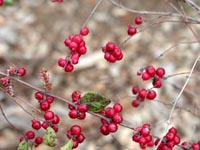Resource Library
Plant of the Week: Indian Currant (Buckbrush)
The University of Arkansas System Division of Agriculture does not promote, support or recommend plants featured in "Plant of the Week." Please consult your local Extension office for plants suitable for your region.
Plant of the Week
Buckbrush, Indian Currant
Latin: Symphoricarpos orbiculatus

The saying goes that to be an expert, you must be at least 100 miles from home. I suspect the same holds true for plants -- to be really appreciated by gardeners, plants must come from somewhere over the horizon, not be something you trip over every time you go for a walk in the woods. Buckbrush has always struck me as a useful landscape plant, but the only landscape I’ve ever seen it purposefully used in was in Germany.
Buckbrush, Symphoricarpos orbiculatus, belongs to the honeysuckle family and grows as a deciduous shrub mostly three to four feet tall. Each plant grows as an independent, arching fountain of branches but is usually seen in small colonies, not alone. These colonies are clones formed from a single plant and may occupy just a few square feet or increase to room-size proportions. The colony forms from ground-hugging stolon that grow horizontally from the base of each plant. When these stolons root, a new shoot will emerge and a new plant develop.
The opposite leaves of buckbrush are usually oval in outline and usually shaped somewhat like the profile of a small pecan. The leaves are held late in the season, and during late falls take on a pleasant butter yellow fall color. In shady sites the leaves will often be marred by a severe case of powdery mildew, which seems to be natures way of keeping this shrub from becoming too rambunctious.
The flowers are insignificant, quarter-inch-long affairs produced in midsummer amongst the upper leaves of the plant. In late summer clusters of reddish-purple, pea-size fruit are produced at the tops of the slender branches which arch over with their weight. The berries persist through the winter and are one of the plant’s most attractive features.
Finding buckbrush is not difficult for it grows almost everywhere east of a line from central North Dakota to central Texas. Native Americans used the slender stolons of buckbrush for weaving beautiful and strong, yet lightweight baskets.
Buckbrush’s common name indicates it must be used as a deer browse plant, but from personal experience, its favor by our feathered friends seems more reserved. As a youth packing my 20 gauge, I dutifully tromped through every colony of buckbrush knowing that any sensible covey of quail would take refuge in the thicket. Apparently quail and I have different notions of refuge, for I’ve never flushed a covey from amongst the tangled branches.
At least one large wholesale nursery is producing buckbrush in containers, but it is still rare to meet with in garden centers and nurseries. Several selections have been made, the most striking of which is the variegated form. The variegation consists of a gold band around each leaf.
Buckbrush will grow in full sun or shade in about any soil. It responds well to cultivation and will be taller and fuller when given even minimal care in the garden. I use it in my shade garden to help define walkway paths and as a foil for planting in front of taller shrubs. It makes an excellent groundcover for slopes that are too steep to mow. If colonies ever get too unruly looking, a springtime visit by a brush hog will whip them back into shape.
By: Gerald Klingaman, retired
Extension Horticulturist - Ornamentals
Extension News - December 7, 2001
The University of Arkansas System Division of Agriculture does not maintain lists of retail outlets where these plants can be purchased. Please check your local nursery or other retail outlets to ask about the availability of these plants for your growing area.